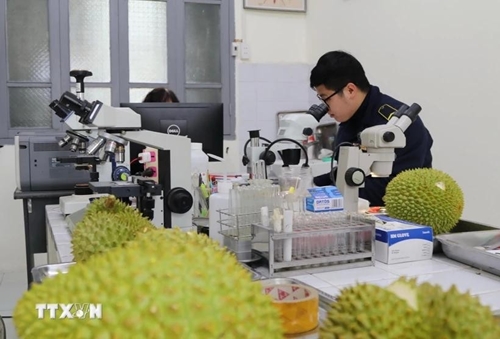The project is carried out in two phases from Q3 of 2024 to the end of Q3 of 2029, with the building of infrastructure from Q3/2024 to the end of Q2/2026, and pilot implementation from Q3/2026.
    |
 |
|
Plant Quarantine staffs at Huu Nghi Border Gate check exported agricultural products. |
Its capital is sourced from the state budget, in association with capital of approved programs and projects, and mobilized from socialization sources and other legal capital as regulated.
The project aims to build the Northern mountainous province of Lang Son, where the Huu Nghi Border Gate is located, into one of the key centers and hubs for import-export, trade and tourism activities in the Northeastern region; and an important gateway for goods trade between ASEAN countries and the Chinese market and other nations.
It also looks to develop Huu Nghi into a model border gate, the most advanced road border gate in the Association of Southeast Asian Nations (ASEAN), based on high technology applications, with a modern road transport system connecting to seaports and airports; while establishing the largest road-based commercial center in Vietnam for trade with ASEAN countries and China, and vice versa.
Accordingly, the smart checkpoints will apply new methods for handling imports and exports based on the use of modern science and technology in the procedures for import-export goods and the entry and exit of vehicles in order to enhance the capacity and efficiency of customs clearance at road border gates, thus meeting the growing trade demand. They will help solve congestion at border gates, reduce transportation customs clearance costs, create a favorable business environment to attract import-export businesses, increase state revenue, and combat smuggling, trade fraud, counterfeit goods, and poor-quality products. It will also contribute to stabilizing and improving the livelihoods of people on both sides of the border, and maintaining political security, social order, and national border sovereignty.
By 2027, the project is expected increase the customs clearance capacity at the specialized freight transport routes by 2-3 times compared the current level. The number of vehicles passing the border checkpoint at the route through the area of Border Markers No.1119 – 1120 will rise from 800 to 2,000 - 2,500 per day, and from 400 to 800 - 1,200 per day for the area of Border Markers No.1088/2 – 1089.
By 2030, the customs clearance capacity at the two routes is projected to increase by 4-5 times compared to the current level, while the number of vehicles will jump to 3,000-3,500 a day and 2,000-2,500, respectively.
The total import-export turnover through the area of Border Markers No.1119 – 1120 is expected to reach approximately USD 85 billion, and about USD 25 billion for the area of Border Markers No.1088/2 – 1089.
Source: VNA